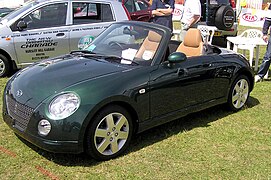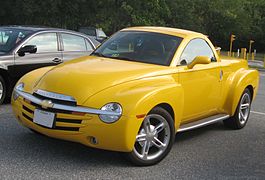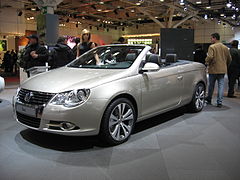Retractable hardtop: Difference between revisions
→Gallery: Opel Astra H Twintop |
m →History |
||
| Line 37: | Line 37: | ||
|df = |
|df = |
||
}}</ref> Produced by French coachbuilding specialist [[Heuliez]], the Macarena's top can be folded in about 30 seconds.<ref name="edmunds"/> It has a reinforcing beam behind the front seats which incorporates LCD screens into the crossmember for the rear passengers.<ref name="edmunds"/> |
}}</ref> Produced by French coachbuilding specialist [[Heuliez]], the Macarena's top can be folded in about 30 seconds.<ref name="edmunds"/> It has a reinforcing beam behind the front seats which incorporates LCD screens into the crossmember for the rear passengers.<ref name="edmunds"/> |
||
'''2011''' The [[Ferrari 488 Spider]] became the first [[Mid-engine, four-wheel-drive layout|mid-engined]] car with a retractable hardtop. The folding mechanisms had to be extensively redesigned to compensate for the engine's placement. Followed shortly thereafter by the [[McLaren 12C|McLaren 12C Spider]] in 2012. |
|||
== Construction == |
== Construction == |
||
| Line 66: | Line 68: | ||
== Gallery == |
== Gallery == |
||
<gallery mode=packed style="font-size:90%; line-height:130%"> |
<gallery mode="packed" style="font-size:90%; line-height:130%"> |
||
File:Mazda MX-5 hardtop.jpg|[[Mazda MX-5|Mazda Miata Power Retractable Hard Top (PRHT)]] c. 2007, with {{convert|77|lb|kg|0|abbr=on}} [[polycarbonate]] hardtop and identical cargo capacity to the soft top version<ref name="autoweek.com"/> |
File:Mazda MX-5 hardtop.jpg|[[Mazda MX-5|Mazda Miata Power Retractable Hard Top (PRHT)]] c. 2007, with {{convert|77|lb|kg|0|abbr=on}} [[polycarbonate]] hardtop and identical cargo capacity to the soft top version<ref name="autoweek.com" /> |
||
File:Cadillac XLR 2006.jpg|[[Cadillac XLR]] c. 2007, with fully retracted aluminum (i.e., lightweight) hardtop concealed by self-storing tonneau cover, the hardtop manufactured by a supplier joint venture of [[Mercedes-Benz]] and [[Porsche]]<ref name="mtrend">{{cite journal | title=2004 Cadillac XLR |journal=Motor Trend |date=August 2002 |first=Jack |last=Keebler | url =http://www.motortrend.com/roadtests/112_0208_cadxlr |accessdate=6 March 2011}}</ref> |
File:Cadillac XLR 2006.jpg|[[Cadillac XLR]] c. 2007, with fully retracted aluminum (i.e., lightweight) hardtop concealed by self-storing tonneau cover, the hardtop manufactured by a supplier joint venture of [[Mercedes-Benz]] and [[Porsche]]<ref name="mtrend">{{cite journal | title=2004 Cadillac XLR |journal=Motor Trend |date=August 2002 |first=Jack |last=Keebler | url =http://www.motortrend.com/roadtests/112_0208_cadxlr |accessdate=6 March 2011}}</ref> |
||
File:Daihatsu.copen.arp.750pix.jpg|[[Daihatsu Copen]] c. 2001 with retracted hardtop, qualifying for the ultra-compact Japanese [[Kei car|Kei]] class |
File:Daihatsu.copen.arp.750pix.jpg|[[Daihatsu Copen]] c. 2001 with retracted hardtop, qualifying for the ultra-compact Japanese [[Kei car|Kei]] class |
||
| Line 73: | Line 75: | ||
File:Chevrolet SSR.jpg|[[Chevrolet SSR]] c. 2004, a retractable hardtop convertible [[pickup truck]], its top engineered by [[American Specialty Cars|ASC]] |
File:Chevrolet SSR.jpg|[[Chevrolet SSR]] c. 2004, a retractable hardtop convertible [[pickup truck]], its top engineered by [[American Specialty Cars|ASC]] |
||
File:Volkswagen Eos Front-view.JPG|[[Volkswagen Eos]] c. 2007, the five-segment top features an independently sliding sunroof, made by [[OASys (Automotive)|OASys]] |
File:Volkswagen Eos Front-view.JPG|[[Volkswagen Eos]] c. 2007, the five-segment top features an independently sliding sunroof, made by [[OASys (Automotive)|OASys]] |
||
File: |
File:Opel Astra TwinTop (H, Facelift) – Heckansicht, 15. Mai 2011, Wuppertal.jpg|[[Opel Astra]] Twintop with a three-part folding metal roof which sits in the upper half of the boot space, leaving considerable luggage space below it. Sold from 2005-2012. |
||
File:2013 Ferrari 458 Spider (73530359).jpeg|Ferrari 458 Spider. The roof is split in to 2 sections, the smaller rear section tucks itself away in a cubby behind the driver while the larger front section flips rearward onto a storage shelf on top of the engine. Due to this, the standard glass engine cover had to be redesigned and resized. |
|||
</gallery> |
</gallery> |
||
Revision as of 23:46, 21 February 2019

A retractable hardtop — also known as "coupé convertible" or "coupé cabriolet" — is a car with an automatically operated, self-storing hardtop, as opposed to the folding textile-based roof used by traditional convertible cars.
The benefits of improved climate control and security are traded off against increased mechanical complexity, cost, weight and often reduced luggage capacity.
A 2006 New York Times article suggested the retractable hardtop may herald the demise of the textile-roofed convertible,[1] and a 2007 Wall Street Journal article suggested "more and more convertibles are eschewing soft cloth tops in favor of sophisticated folding metal roofs, making them practical in all climates, year-round."[2]
History



1919 Ben P. Ellerbeck conceived a retractable hardtop – a manually operated system on a Hudson coupe that allowed unimpeded use of the rumble seat even with the top down[3] – but never saw production.[4]
1935 Peugeot introduced the first production, power-operated retractable hardtop in 1935, the 402 Éclipse Décapotable,[1][5][6] designed and patented by Georges Paulin.[1] The French coachbuilder, Marcel Pourtout, custom-built other examples of Paulin's designs on a larger Peugeot chassis as well.[1] The first Eclipse 402s offered a power-retractable top, but in 1936 was replaced by a manually operated version on a stretched chassis, built in limited numbers until World War II.[3]
1941 Chrysler introduced a retractable hardtop concept car, the Chrysler Thunderbolt.[3]
1953 Ford Motor Company spent an estimated US$2 million (US$22,776,119 in 2023 dollars[7]) to engineer a Continental Mark II with a servo-operated retractable roof. The project was headed by Ben Smith, a 30-year-old draftsman.[8] The concept was rejected for cost and marketing reasons.[3] Engineering work was recycled to the Ford Division which used the retractable mechanism in their 1957-1959 flagship Ford Fairlane 500 Skyliner after an estimated US$18 million (US$195,270,142 in 2023 dollars[7]) more was spent.[9]
1955 Brothers Ed and Jim Gaylord showed their first prototype at the 1955 Paris motor show,[10] but the car failed to reach production.
1957 Ford introduced the Fairlane 500 Skyliner in the United States. A total of 48,394 were built from 1957 to 1959.[3] The retractable top was noted for its complexity and usually decent reliability[11][12] in the pre-transistor era. Its mechanism contained 10 power relays, 10 limit switches, four lock motors, three drive motors, eight circuit breakers, as well as 610 feet (190 m) of electrical wire,[3] and could raise or lower the top in about 40 seconds. The Skyliner was a halo car with little luggage space (i.e., practicality), and cost twice that of a baseline Ford sedan.
1989 Toyota introduced a modern retractable hardtop, the MZ20 Soarer Aerocabin. The car featured an electric folding hardtop and was marketed as a 2-seater with a cargo area behind the front seats. Production was 500 units.
1995 The Mitsubishi GTO Spyder by ASC was marketed in the U.S.[4] The design was further popularized by such cars as the 1996 Mercedes-Benz SLK.[1] and 2001 Peugeot 206 CC.
2006 Peugeot presented a concept four-door retractable hardtop convertible, the Peugeot 407 Macarena.[13] Produced by French coachbuilding specialist Heuliez, the Macarena's top can be folded in about 30 seconds.[13] It has a reinforcing beam behind the front seats which incorporates LCD screens into the crossmember for the rear passengers.[13]
2011 The Ferrari 488 Spider became the first mid-engined car with a retractable hardtop. The folding mechanisms had to be extensively redesigned to compensate for the engine's placement. Followed shortly thereafter by the McLaren 12C Spider in 2012.
Construction

Retractable hardtops are commonly made from between two and five sections of metal or plastic and often rely on complex dual-hinged trunk/boot lids that enable the trunk lid to both receive the retracting top from the front and also receive parcels or luggage from the rear. The trunk also often includes a divider mechanism to prevent loading of luggage that would conflict with the operation of the hardtop.
Variations
- The Volkswagen Eos features a five-segment retractable roof where one section is itself an independently sliding transparent sunroof.[2]
- The Mercedes SL hardtop features a glass section that rotates during retraction to provide a more compact "stack."
- The Mazda MX-5 has been available since the 2006 model year with an optional power retractable hardtop, in lieu of the standard folding-textile soft-top. Compared to the regular soft-top, the hardtop weighs 77 lb (35 kg) more yet has no reduction in cargo capacity.[14] The MX-5 is one of the few cars offering both hardtop and soft-top convertible choices. The hardtop roof is constructed of polycarbonate and manufactured by the German firm Webasto.[15]
- The Chrysler Sebring's (and its successor the Chrysler 200's) retractable hardtop also is marketed alongside a soft-top. According to development engineer Dave Lauzun, during construction, the Karmann-made tops are dropped into a body that is largely identical: both soft-top and retractable feature the same automatic tonneau cover, luggage divider and luggage space.[16] The retractable does feature an underbody cross-brace not included in the softtop.
Comparison with soft tops
The retractable hardtop's advantages include:
- More weatherly when roof is raised
- More secure than fabric tops[2][17]
- Increased structural rigidity
- May enable consolidation/simplification of a manufacturer's car lineup; for instance the current BMW Z4 (E89) is offering only as a coupé-convertible (hardtop), compared to the preceding E85 generation that had separate coupé and cabriolet (soft-top) variants.
The retractable hardtop's disadvantages include:
- Higher initial cost
- Increased mechanical complexity
- Potentially diminished passenger and trunk space compared to a soft-top convertible.[18][19]
- Higher weight and center of gravity than soft-top convertibles, potentially reducing handling.[20][18][19]
- Potential need for more than minimum clearance while operating the hardtop. For example, the Volvo C70 requires 6.5 feet (2 m) of vertical clearance during operation[21], the Cadillac XLR requires 6 ft 10+1⁄2 in (2 m) of vertical clearance and the Mercedes SLK's trunk lid extends rearward while lowering or lifting the top.
List of retractable hardtop models
Gallery
-
Mazda Miata Power Retractable Hard Top (PRHT) c. 2007, with 77 lb (35 kg) polycarbonate hardtop and identical cargo capacity to the soft top version[14]
-
Cadillac XLR c. 2007, with fully retracted aluminum (i.e., lightweight) hardtop concealed by self-storing tonneau cover, the hardtop manufactured by a supplier joint venture of Mercedes-Benz and Porsche[22]
-
Daihatsu Copen c. 2001 with retracted hardtop, qualifying for the ultra-compact Japanese Kei class
-
Ford Focus CC c. 2006 with its roof retracted, its final assembly performed by Pininfarina
-
Volkswagen Eos c. 2007, the five-segment top features an independently sliding sunroof, made by OASys
-
Opel Astra Twintop with a three-part folding metal roof which sits in the upper half of the boot space, leaving considerable luggage space below it. Sold from 2005-2012.
-
Ferrari 458 Spider. The roof is split in to 2 sections, the smaller rear section tucks itself away in a cubby behind the driver while the larger front section flips rearward onto a storage shelf on top of the engine. Due to this, the standard glass engine cover had to be redesigned and resized.
References
- ^ a b c d e Sass, Rob (10 December 2006). "New Again: The Hideaway Hardtop". The New York Times. Retrieved 6 March 2011.
- ^ a b c Vella, Matt (26 April 2007). "Convertibles with Hard Tops". The Wall Street Journal. Retrieved 3 February 2014.
- ^ a b c d e f Nerad, Jack. "Ford Skyliner". Driving Today. Archived from the original on 21 February 2014. Retrieved 3 February 2014.
{{cite web}}: Unknown parameter|deadurl=ignored (|url-status=suggested) (help) - ^ a b "History, Revival". Retractable Hardtop Online. Retrieved 3 February 2014.
- ^ "Disappearing Top On Auto Worked By Push Button". Popular Mechanics. 63 (2): 253. February 1935. Retrieved 14 August 2013.
- ^ "Latest Foreign Auto Has Disappearing Top". Popular Mechanics. 65 (1): 53. January 1936. Retrieved 14 August 2013.
- ^ a b 1634–1699: McCusker, J. J. (1997). How Much Is That in Real Money? A Historical Price Index for Use as a Deflator of Money Values in the Economy of the United States: Addenda et Corrigenda (PDF). American Antiquarian Society. 1700–1799: McCusker, J. J. (1992). How Much Is That in Real Money? A Historical Price Index for Use as a Deflator of Money Values in the Economy of the United States (PDF). American Antiquarian Society. 1800–present: Federal Reserve Bank of Minneapolis. "Consumer Price Index (estimate) 1800–". Retrieved February 29, 2024.
- ^ Merlis, Bob (6 March 2007). "Lucy Loved Ford's First Hard Top Convertible". GreatcarsTV.com. Archived from the original on 22 December 2008.
{{cite web}}: Unknown parameter|dead-url=ignored (|url-status=suggested) (help)[failed verification] - ^ Aaron Severson. "Raising the Roof: The Ford Skyliner 'Retrac'". Ate Up With Motor. Retrieved 2016-12-09.
- ^ Auto Editors of Consumer Guide (13 November 2007). "1950 Gaylord concept cars". Howstuffworks.com. Retrieved 6 March 2011.
{{cite web}}:|author=has generic name (help) - ^ Willson, Quentin (1995). The Ultimate Classic Car Book. DK Publishing. ISBN 0-7894-0159-2.
- ^ the Auto Editors of Consumer Guide (20 July 2007). "1957-1959 Ford Fairlane 500 Skyliner". Auto.howstuffworks.com. Retrieved 14 August 2013.
{{cite web}}:|author=has generic name (help) - ^ a b c
"¡Hey, Macarena! Heuliez Creates an Open-Top Peugeot 407". Edmunds, 01-28-2006. Archived from the original on 2006-12-19.
{{cite web}}: Unknown parameter|deadurl=ignored (|url-status=suggested) (help) - ^ a b Vaughn, Mark (10 September 2006). "2007 Mazda MX-5 Miata Power Retractable Hardtop". Autoweek. Retrieved 6 March 2011.
- ^ "2007 Mazda MX-5 Miata Hardtop". Car and Driver. 1 September 2006. Retrieved 28 June 2018.
- ^ Lauzun, Dave. "2008 Chrysler Sebring Convertible". Autonetwork.com. Retrieved 3 February 2014.
- ^ "Great Drive: Luxury Hardtop Convertible Comparison". Automobile. August 2009. Retrieved 14 August 2013.
- ^ a b St. Antoine, Arthur (May 2010). "Luxury Convertible Comparison: 2010 Audi A5 vs 2010 BMW 335i vs 2009 Infiniti G37 vs 2010 Lexus IS 350". Motor Trend. Retrieved 3 February 2014.
- ^ a b Swan, Tony (June 2007). "2007 VW Eos vs. Audi A4, BMW 328i, Volvo C70, Saab 9-3 – Comparison Tests". Caranddriver.com. Retrieved 3 February 2014.
- ^ Swan, Tony (March 2010). "2010 Audi A5 2.0T Quattro vs. 2010 BMW 328i, 2009 Infiniti G37, 2010 Lexus IS350C – Comparison Tests". Car and Driver. Retrieved 3 February 2014.
- ^ "2007 Volvo C70". Volvocars.com, C70 owner documentation, Page 93. Retrieved 3 February 2014.
- ^ Keebler, Jack (August 2002). "2004 Cadillac XLR". Motor Trend. Retrieved 6 March 2011.

![Mazda Miata Power Retractable Hard Top (PRHT) c. 2007, with 77 lb (35 kg) polycarbonate hardtop and identical cargo capacity to the soft top version[14]](/media/wikipedia/commons/thumb/c/c4/Mazda_MX-5_hardtop.jpg/320px-Mazda_MX-5_hardtop.jpg)
![Cadillac XLR c. 2007, with fully retracted aluminum (i.e., lightweight) hardtop concealed by self-storing tonneau cover, the hardtop manufactured by a supplier joint venture of Mercedes-Benz and Porsche[22]](/media/wikipedia/commons/thumb/9/97/Cadillac_XLR_2006.jpg/257px-Cadillac_XLR_2006.jpg)





